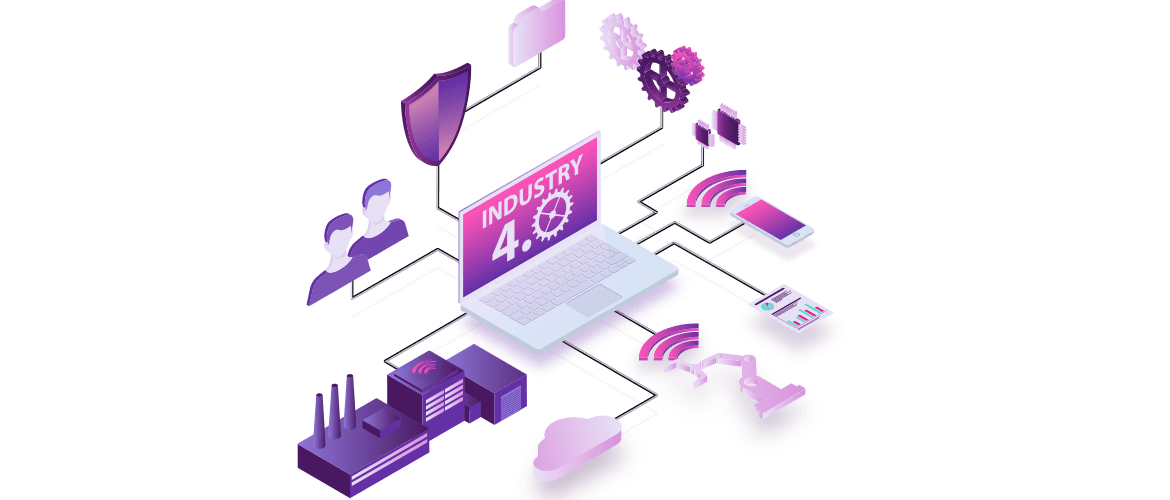What is industry4.0
The first industrial revolution began 18 In Britain in the late 1900s, the British replaced pure human and animal power with water and steam power, helping to achieve mass production. The finished product comes from machine making instead of painstaking hand making.
A century later, the Second Industrial Revolution introduced assembly lines and the use of oil, gas and electricity. These new sources of energy, as well as more advanced communications through telephone and telegraph, have enabled the manufacturing process to have large-scale production capacity and a certain degree of automation.
The third industrial revolution began 20 In the middle of the century, computers were added to the manufacturing process as well as advanced telecommunications and data analysis. Programmable logic controller (PLC) Embedded in machines to help automate certain processes and collect and share data, factory digitization begins.
We are now in the middle of the fourth industrial revolution, also known as industry4.0, Characterized by increased automation and the use of smart machines and smart factories, data insights help produce goods more efficiently throughout the value chain. The flexibility of production has been improved, and manufacturers can better meet customer needs through mass customization-in many cases, ultimately seeking to achieve efficiency gains through minimal production batches. By collecting more data from the factory floor and combining it with other business operation data, smart factories can achieve information transparency and better decision-making.
Industry4.0 How Technology Is Changing Manufacturing
Industry4.0 Is revolutionizing the way companies manufacture, improve, and distribute their products. Manufacturers are including the Internet of Things (IoT)New technologies including, cloud computing and analytics, and artificial intelligence and machine learning are integrated into their production facilities and throughout their operations.
Equipped with advanced sensors, embedded software, and robotics, these smart factories can collect and analyze data and make better decisions. When the data from production operations and the data from ERPOperational data from, supply chain, customer service, and other enterprise systems can be combined to create greater value when creating new visibility and insight from previously isolated information.
Industry4.0 This digital technology improves automation, predictive maintenance, self-optimization for process improvement, and most importantly, takes efficiency and responsiveness to customers to unprecedented new levels.
The development of smart factories provides a rare opportunity for the manufacturing industry to enter the fourth industrial revolution. Analyzing the vast amounts of big data collected from sensors on the factory floor ensures real-time visibility of manufacturing assets and can provide tools for performing predictive maintenance to minimize equipment downtime.
Using high-tech IoT devices in smart factories can improve productivity and quality. With AI Driven visual insight replaces manual examination of business models to reduce error making and save money and time. With a minimum investment, quality control personnel can set up smartphones connected to the cloud to monitor the manufacturing process from almost anywhere. By applying machine learning algorithms, manufacturers can detect errors immediately, rather than at a later stage where repair work is more expensive.
Industry4.0 Concepts and technologies can be applied to all types of industrial companies, including discrete and process manufacturing, as well as oil and gas, mining, and other industrial sectors.
Which technologies are driving industry4.0 DEVELOPMENT
Internet of Things (IoT)
Internet of Things (IoT) Is a key component of a smart factory. Machines on the factory floor are equipped with sensors that have IP Address, which allows the machine to establish connections with other network-enabled devices. This mechanization and connectivity makes it possible to collect, analyze and exchange large amounts of valuable data.
Cloud Computing
Cloud computing is any industry4.0 The cornerstone of strategy. The full realization of intelligent manufacturing requires the interconnection and integration of engineering, supply chain, production, sales, distribution and services. Cloud technology helps make that happen. In addition, large amounts of data stored and analyzed can often be processed more economically and efficiently with the help of cloud computing. Cloud computing can also reduce start-up costs for small and medium-sized manufacturers, who can adjust demand and scale as their business grows.
AI And machine learning;
AI And machine learning enable manufacturing enterprises to take full advantage of the vast amount of information from the factory floor, various business units, and even from partners and third parties. AI And machine learning can bring deep insights that enable visibility, predictability, and automation of operations and business processes. For example: industrial machines are prone to failure during production. Leveraging the data collected from these assets can help enterprises perform predictive maintenance based on machine learning algorithms, increasing uptime and improving efficiency.
Edge Computing
The need for real-time production operations means that some data analysis must be done at the "edge" (i.e., where the data is created). This minimizes the delay from when the data is generated to when it needs to be reacted. For example, detecting safety or quality issues may require near-real-time operation of the device. The time it takes to send data to the enterprise cloud and then back to the factory floor can be too long and depends on the reliability of the network. Using edge computing also means that data remains close to the source, reducing security risks.
Cybersecurity
Manufacturing firms don't always consider the importance of cybersecurity or cyber-physical systems. While plant or site operating equipment; (OT) Having the same connectivity can improve the efficiency of the manufacturing process, but it also exposes new entry paths for malicious attacks and malware. In-to-industry 4.0 In the process of digital transformation, it is necessary to consider adopting a method that includes IT And OT Network security methods for devices.
Digital twins
Industry4.0 The resulting digital transformation enables manufacturers to create digital twins, virtual copies of processes, production lines, factories, and supply chains. By starting from IoT Sensors, devices,PLC And other Internet-connected devices can extract data to create digital twins. Manufacturers can use digital twins to boost productivity, improve workflows and design new products. For example, by simulating production processes, manufacturers can test process changes to find ways to minimize downtime or increase capacity.
Features of Smart Factory
Data analytics designed to optimize decision-making;
Embedded sensors and interconnected mechanical equipment generate a large amount of big data for manufacturing enterprises. Data analysis helps manufacturers investigate historical trends, identify patterns, and make better decisions. Smart factories can also leverage data from other parts of the enterprise and extensions of the supplier and distributor ecosystem to gain deeper insights. By looking at data from human resources, sales, or warehousing departments, manufacturers can make production decisions based on sales margins and staffing. Create"Digital twins can fully reflect operating conditions in a digital way."
IT-OT Integration
The network architecture of a smart factory relies on interconnection. Real-time data collected from sensors, equipment and machines on the factory floor can be immediately used by other factory assets and shared among other software in the enterprise software stack, This includes enterprise resource planning (ERP) And other business management software.
Custom manufacturing
Smart factories can produce customized goods that meet customer needs more cost-effectively. In fact, in many industrial areas, manufacturers are eager to achieve in an economical way"Minimum production batch". Through the use of advanced simulation software applications, new materials and 3D Printing and other technologies, manufacturers can easily produce small batches of specialized products for specific customers. The first industrial revolution was related to mass production, and industry 4.0 It is related to mass customization.
Supply Chain
Industrial operations rely on transparent and efficient supply chains. As a robust industry4.0 As part of the strategy, the supply chain must be integrated with production operations. This has changed the way manufacturers acquire raw materials and deliver finished products. By sharing some production data with suppliers, manufacturers can better schedule deliveries. For example, if an assembly line is disrupted, deliveries can be rescheduled or delayed to reduce time or cost wastage. In addition, by studying weather, shipping partner, and retailer data, businesses can use predictive shipping to send finished products at the right time to meet consumer needs. Blockchain is becoming a key technology to improve supply chain transparency.










